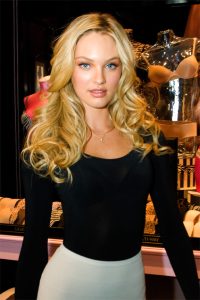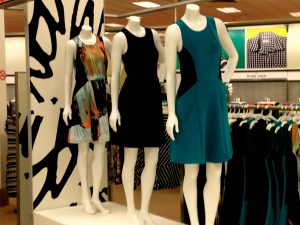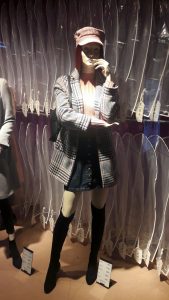Early 2010s (2010–2012)
1980s Influences

The early 2010s saw many recycled fashions from the 1950s, 1970s, and 1980s as designers from stores like Topshop replicated original vintage clothing. In the United States, it was popular to wear Gucci, Chanel, or Versace designer clothing, and neon colors such as pink, green, teal, black, purple, magenta, and yellow.
Tribal fashions and 1990s revival

From late 2011 onward, 1990s inspired fashion began to make a comeback in the UK, US, Philippines, India, and Australasia among teen girls and young women aged 15–30. Popular upper apparel included Christmas sweaters, T-shirts with blazers, plaid, oversized flannel shirts worn or tied around the waist, oversized T-shirts, padded gilets, Penshoppe skater skirts (in the Philippines), skorts, crew neck sweaters, T-shirts bearing the word Nerd or Geek, destroyed acid wash Balmain jeans, and crop tops. In the UK and the US, popular bottom apparel includes skinny jeans, leggings, parachute pants,[29] railroad stripe pants or skirts, boyfriend jeans.
Eastern fashions and carry-over styles

Many fashion trends from the early years of the decade, especially the 1980s influences and the 1960s inspired indie, neo-hippie and boho chic looks, remained relevant in the US and Europe as far as 2017. This included skinny jeans, tunics, floral print dresses, midi and maxi skirts, motorcycle jackets, western shirts, red and blue geometric print blouses, patterned and solid colored tights, overalls,[41] jogger pants,[42] flat boots, stiletto shoes, Nike Tempo shorts, pastel and neon colored shorts, ballet flats, and combat boots.
Mid 2010s (2013–2016)
Monochromatic and printed clothing

By the mid-2010s, neon colors were out of style in Europe, America, and Australia. More subdued colors became popular such as burgundy, mustard yellow, olive green, mauve, and blush pink. Bright colors were also replaced by black, white, various shades of gray,[49] and charcoal first on the catwalk, and later as street fashion.
Monochromatic clothing trends from 2013 to 2017 included black and white lace dresses, lace blouses, jackets and dresses with peter pan collars, white Adidas Superstar sneakers with black or gold stripes, houndstooth or geometric patterned blazers, black or nude slip dresses.
Costume jewelry and onesies
Loom bands, bracelets woven from brightly colored rubber bands, were seen as both a global fashion statement and a children’s fad. In France, Ireland and America, 1990s-inspired Choker necklaces featuring colored glass beads, silver chain link, artificial diamonds, Swarovski crystals, lace, velvet, and black or red leather had returned to popularity.
Hippie and grunge influences
The early to mid 2010s witnessed a revival of grunge fashion in America with more of an “edgy” interest of denim ripped jeans and ripped jackets,[81] flannels, animal print coats, printed t-shirts which were frequently color or stone faded, black combat boots, biker boots, and leather motorbike jackets.
Late 2010s (2017–2019)
1970s revival

From 2017 to 2021, the brightly colored beige, red, green, brown and orange[100] 1970s revival fashions began to replace the grey and monochromatic 1990s inspired streetwear in Britain, India,[101] North America and France.
Mature look
By 2017, it had also become fashionable for younger middle-class women in Britain, Ireland, Norway, Sweden, Australia, New Zealand, Canada, Denmark, and Finland[130] to wear more “grown up” or normcore[131] styles, in reaction to the previous mismatched hipster fashions and the athleisure trend of 2014 which mixed traditional formal wear with high end sportswear.